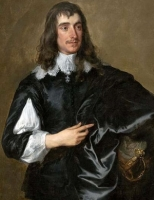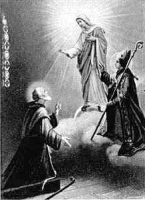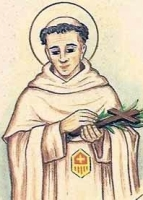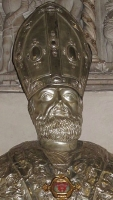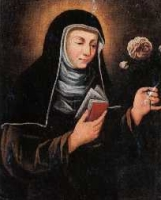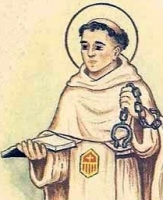Saint Thomas a Becket
புனிதர் தாமஸ் பெக்கட்
கேன்டர்பரி பேராயர்/ மறைசாட்சி:
பிறப்பு: டிசம்பர் 21, 1118
சீப்சைட், லண்டன்
இறப்பு: டிசம்பர் 29, 1170
கேன்டர்பரி பேராலயம்
ஏற்கும் சமயம்:
ரோமன் கத்தோலிக்க திருச்சபை
ஆங்கிலிக்கன் சமூகம்
முக்திபேறு பட்டம்: ஃபெப்ரவரி 21, 1173
திருத்தந்தை மூன்றாம் அலெக்சாண்டர்
புனிதர் பட்டம்: ஃபெப்ரவரி 21, 1173
திருத்தந்தை மூன்றாம் அலெக்சாண்டர்
முக்கிய திருத்தலம்:
கேன்டர்பரி பேராலயம்
நினைவுத் திருநாள்: டிசம்பர் 29
புனிதர் தாமஸ் பெக்கட், கி.பி. 1162ம் ஆண்டு முதல் கி.பி. 1170ம் ஆண்டில் மறைசாட்சியாக கொலை செய்யப்படும்வரை “கேன்டர்பரி பேராயராக” (Archbishop of Canterbury) இருந்தவராவார். கத்தோலிக்க திருச்சபை மற்றும் ஆங்கிலிக்க ஒன்றியம் இவரை புனிதர் என்றும் மறைசாட்சி என்றும் வணங்குகின்றது. கி.பி. 1162ம் ஆண்டில், கேன்டர்பரி பேராயரின் மறைவுக்குப்பின், தனக்குச் சாதகமாக இருப்பார் என்று கருதி, அப்போது இங்கிலாந்து நாட்டின் மன்னராக (King of England) இருந்த “இரண்டாம் ஹென்றி” (Henry II), தாமஸ் பெக்கெட்டை பேராயராகப் பரிந்துரைத்தார். திருச்சபையின் உரிமைகள் மற்றும் சலுகைகள் பற்றி அவர் இங்கிலாந்தின் மன்னரான இரண்டாம் ஹென்றியுடன் மோதலில் ஈடுபட்டார். இதன் காரணமாக, இவரை மன்னரின் ஆட்கள் இவரின் மறைமாவட்டப் பேராலயத்திலேயே வெட்டிக்கொன்றனர்.
அப்போஸ்தலரான புனிதர் தோமையரின் நினவுத் திருநாளான டிசம்பர் மாதம் 21ம் தேதி பிறந்த பெக்கட்'டின் தந்தையின் பெயர், “கில்பர்ட் பெக்கட்” (Gilbert Beket) ஆகும். தாயாரின் பெயர், “மெட்டில்டா” (Matilda) ஆகும். ஒரு துணி-ஆடை வியாபாரியாக வாழ்க்கையைத் தொடங்கிய கில்பர்ட், கி.பி. 1120களில் லண்டன் மாநகரில் உள்ள தமது சொத்துக்களின்பேரில் வாடகையாக வந்த வருமானத்தைக் கொண்டு வசதியாக வாழ்ந்தவர். சில காலம் இவர் லண்டன் மாநகரின் தலைவராகவும் (Sheriff) இருந்திருக்கிறார். கில்பர்ட்டின் பணக்கார சிநேகிதர்களில் ஒருவரான "ரிச்சர் டி லா'ஐக்லே" (Richer de L'Aigle) என்பவர், வேட்டையாடுவதில் ஆர்வமுள்ள தாமசை "ஸுஸ்செக்ஸ்" (Sussex) என்னுமிடத்திலுள்ள தமது தோட்டங்களுக்கு அடிக்கடி அழைப்பதுண்டு. தாமஸ், 'ரிச்ச'ரிடமிருந்து நிறைய விடயங்களைக் கற்றுக்கொண்டார். பின்னாளில், தாமசுக்கு எதிரான க்ளேரண்டன் அரசியல் சட்டத்தில் (Signatory of the Constitutions of Clarendon) கையெழுத்திட்டவர் ரிச்சர் ஆவார் என்பது குறிப்பிடத்தக்கது.
தமது பத்து வயதில் லண்டன் புனித பவுல் தேவாலயத்தின் "மெர்டன்" துறவு மடத்தில் (Merton Priory) கல்வி கற்க அனுப்பப்பட்டார். தமது இருபது வயதில் சுமார் ஒரு வருடம் பாரிஸ் நகரில் இருந்த இவர், நியதி அல்லது சிவில் சட்டம் ஆகியவற்றை கற்கவில்லை.
கேன்டர்பரியின் பேராயரான "தியோபால்ட்" (Theobald) என்பவர் தாமசின் பேரில் கொண்ட நம்பிக்கையின் பேரில், தமாசை முக்கிய சில பணிகளுக்காக ரோம் மற்றும் 'போலோக்னா' (Rome and Bologna) ஆகிய இடங்களுக்கு அனுப்பினார். அத்துடன், அவரை கிறிஸ்தவ சமயச் சட்டங்கள் கற்பதற்காக "ஆக்செர்ரே" (Auxerre) நாட்டுக்கும் அனுப்பினார்.
தாமசின் திறமையில் அதிக நம்பிக்கை கொண்ட தியோபால்ட், அச்சமயம் காலியாக இருந்த (Lord Chancellor) பதவிக்கு தாமசை நியமிக்கும்படி அப்போதைய அரசன் இரண்டாம் ஹென்றியிடம் பரிந்துரைத்தார். கி.பி. 1155ம் ஆண்டு, ஜனவரி மாதம் தாமஸ் அவ்வுயர் பதவிக்கு நியமிக்கப்பட்டார். நிலக்கிழார்கள், தேவாலயங்கள் மற்றும் ஆயர் பேரவைகள் ஆகியனவற்றிலிருந்து அரசனின் பாரம்பரிய வருவாய்களை வசூலிக்கும் பணியில் கறாராக இருந்தார். அரசன் தமது மகனான ஹென்றியை தாமசின் இல்லத்தில் தங்குவதற்கு அனுப்பினார். அக்காலத்தில் அரச வாரிசுகள் வெளி பிரபுக்களின் இல்லங்களில் தங்குவது பாரம்பரிய செயலாக இருந்தது. தாமஸ் தம் மீது தமது தந்தையை விட அதிகளவு பாசம் வைத்திருந்ததாக ஹென்றி கூறினார்.
கி.பி. 1162ம் ஆண்டு, கேன்டர்பரியின் பேராயரான "தியோபால்ட்டின்" மரணத்தின் பின்னர், தாமஸ் பேராயர் பதவிக்கு முன்மொழியப்பட்டார். கி.பி. 1162ம் ஆண்டு, மே மாதம், 23ம் நாள், அரசவை ஆயர் மற்றும் பிரபுக்கள் குழுக்களால் அவரது தேர்தல் உறுதி செய்யப்பட்டது. தாமஸ், திருச்சபையை விட அரச பணிகளுக்கே முக்கியத்துவம் தருவார் என அரசன் எதிர்பார்த்தார். ஆனால், துறவு வாழ்விற்கான தாமசின் பிரசித்தி பெற்ற மாற்றம் அப்போது நிகழ்ந்தது.
கி.பி. 1162ம் ஆண்டு, ஜூன் மாதம், இரண்டாம் நாள் குருத்துவம் பெற்ற தாமஸ் பெக்கட், “வின்செஸ்டர்” மாகாணத்தின் ஆயர் "ப்லாய்சின் ஹென்றி" (Henry of Blois, the Bishop of Winchester) மற்றுமுள்ள கேன்டர்பரியின் ஆயர்களால் கி.பி. 1162ம் ஆண்டு, ஜூன் மாதம், 3ம் நாள், கான்டர்பரியின் பேராயராக அருட்பொழிவு செய்யப்பட்டார்.
புதிதாக நியமனம் பெற்ற பேராயர் தம்மிடம் ஏற்கனவே இருந்த (Lord Chancellor) பதவியை ராஜினாமா செய்ததாலும், பேராயருக்கான உரிமைகள் மற்றும் அதிகாரங்களை திரும்ப தம்மிடமே தரவேண்டுமென கோரியதாலும் தாமஸ் பெக்கட் மற்றும் அரசன் இரண்டாம் ஹென்றியின் மத்தியில் பிளவு அதிகரிக்கத் தொடங்கியது. ஆங்கிலேய பாதிரியார்கள் மீதுள்ள மதச்சார்பற்ற நீதிமன்றங்களின் தீர்ப்புகள் உள்ளிட்ட இவை, இவ்விருவரிடையே தொடர் மோதல்களுக்கும் வெறுப்புக்கும் வழி வகுத்தது. பெக்கெட்டுக்கு எதிராக மற்ற ஆயர்களின் செல்வாக்கைப் பெற "வெஸ்ட்மின்ஸ்டரில்" (Westminster) ஹென்றி மேற்கொண்ட முயற்சிகள், அக்டோபர் கி.பி. 1163ல் தொடங்கியது. தாமஸ் பெக்கெட்டின் மீது நடவடிக்கை எடுக்க "ராயல் அரசிடமிருந்து" (Royal government) பாரம்பரிய ஒப்புதலை ஹென்றி கேட்டுப் பெற்றார். இதனால், அரசர் ஹென்றியின் உரிமைகளுக்கு ஒப்புக்கொள்ளும்படியும், தவறினால் அரசியல் பின்விளைவுகளை சந்திக்க நேரிடும் என்றும் தாமஸ் பெக்கட் "க்ளேரண்டன்" (Clarendon) மூலமாக அதிகாரபூர்வமாக கேட்டுக்கொள்ளப்பட்டார்.
"க்ளேரண்டனின்" அரசியலமைப்பு:
கி.பி. 1164ம் ஆண்டு, ஜனவரி மாதம், 30ம் நாளன்று, "க்ளேரண்டன்" அரண்மனையில் பெரும்பான்மையான ஆங்கிலேய கிறிஸ்தவ குருமார்கள் கலந்துகொண்ட கூட்டத்திற்கு அரசர் இரண்டாம் ஹென்றி தலைமை வகித்தார். தமது முழு திறமையையும் அதிகாரத்தையும் உபயோகித்து தாமஸ் பெக்கட்டுக்கு எதிராக பதினாறு அரசியலமைப்புகளிலும் ஆங்கிலேய கிறிஸ்தவ குருமார்களின் ஒப்புதலைப் பெற்றார். வேறு வழியற்ற பெக்கட், "க்ளேரண்டன்" அரசியல் சட்ட உட்பொருளுக்கு ஒப்புகொண்டு தமது விருப்பத்தை வெளிப்படுத்தினார். ஆனாலும் அவற்றில் கையெழுத்திட மறுத்தார்.
கி.பி. 1164ம் ஆண்டு, அக்டோபர் மாதம், 8ம் நாளன்று, "நார்த்தாம்டனின் கோட்டையில்" நடந்த மகா சபையில் (Great Council at Northampton Castle) ஆஜராகி, அரசு அதிகார அவமதிப்பு மற்றும் தவறான செயல்பாடு போன்ற குற்றச்சாட்டுக்களுக்கு பதிலளிக்குமாறு பெக்கெட்டுக்கு ஹென்றி உத்தரவிட்டார். மகாசபையில் ஆஜரான குற்றம் சாட்டப்பட்ட பெக்கட்,விசாரணையிலிருந்து எறியப்பட்டார். தண்டனையாக கண்டம் விட்டு கண்டம் கடத்தப்பட்டார்.
நாடு கடத்தலும் அஞ்ஞாத வாசமும்:
பெக்கட் தப்பியோடிய பேராயராக அறிவிக்கப்பட்டு, அவர் மீதும் அவரது உதவியாளர்கள், நண்பர்கள் மற்றும் நலன் விரும்பிகள் ஆகிய அனைவருக்கெதிராகவும் அரசர் ஹென்றி தொடர் அரசாணைகளைப் பிறப்பித்தார். ஆனால், ஃபிரான்ஸ் நாட்டின் அரசர் ஏழாம் லூயிஸ் (King Louis VII) பெக்கட்டுக்கு பாதுகாப்பளித்தார். ஹென்றியின் கிறிஸ்தவ திருச்சபைக்கு எதிரான பயமுறுத்தல்கள் தீரும்வரை பெக்கட், ஃபிரான்ஸின் 'பொன்டிக்னி' எனும் இடத்திலுள்ள சிஸ்ட்டர்சியன்' மடத்தில் (Cistercian abbey of Pontigny) சுமார் இரண்டு வருடங்களைக் கழித்தார்.
திருத்தந்தை மூன்றாம் அலெக்சாண்டர் பெக்கட் மீது அனுதாபம் கொண்டிருந்தாலும், ஒரு சாதகமான இராஜதந்திர அணுகுமுறையையே நாடினார். கி.பி. 1167ம் ஆண்டு, திருத்தந்தை பிரதிநிதிகள் (Papal legates) அதிகாரபூர்வமாக அனுப்பப்பட்டனர்.
இறுதியில், சர்ச்சைகளுக்கு தீர்வு காணும் நோக்கில், பேரரசர் அலெக்சாண்டர் கி.பி. 1170ம் ஆண்டு, இங்கிலாந்துக்கு தமது பிரதிநிதிகளை அனுப்பினார். வேறு வழியற்ற ஹென்றி, தாமஸ் வெளிநாட்டில் இருந்து இங்கிலாந்து திரும்பிச் செல்ல அனுமதிகும் ஒரு சமரசத்திற்கு ஒப்புக்கொண்டான்.
அரசியல் படுகொலை (Assassination):
கி.பி. 1170ம் ஆண்டு, ஜூன் மாதம், "யோர்க்" பேராயர் (The Archbishop of York), "லண்டன்" ஆயர் (Bishop of London), மற்றும் "ஸலிஸ்பரி" ஆயர் (Bishop of Salisbury) ஆகியோர் இணைந்து "யோர்க்" நகரில் இரண்டாம் ஹென்றியின் மகனான இளைய ஹென்றிக்கு அரச முடி சூட்டினர். இது, கான்டர்பரியின் முடிசூட்டும் தனி உரிமையை முடிவுக்கு கொண்டுவந்தது. அதே வருடம் நவம்பர் மாதம்,பெக்கட் இம்மூன்று ஆயர்களை கிறிஸ்தவ திருச்சபையிலிருந்து விலக்கி வைத்தார். மூன்று ஆயர்களும் "நார்மண்டியிலுள்ள (Normandy) அரசரைக் காண விரைந்திருந்த வேளையிலும் பெக்கட் தமது எதிர்ப்பாளர்களை விலக்கியே வைத்தார். இத்தகவல்கள் யாவும் இளம் அரசன் ஹென்றியின் தந்தையான இரண்டாம் ஹென்றியின் காதுக்கு சென்றடைந்தது. தகவல்களைக் கேட்டறிந்ததும் கோபமுற்ற இரண்டாம் ஹென்றி உச்சரித்த வார்த்தைகளை அவரது உதவியாளர்கள் விவரிக்கின்றனர். ஆனால் அவற்றுக்கான சரியான நிரூபணங்கள் இன்னதான் என்று எங்கும் குறிப்பிடப்பட்டிருக்கவில்லை. பொதுவான மேற்கோல்களின்படி, "யார் இந்த தொல்லை வாய்ந்த கிறிஸ்தவ குருவை ஒழித்துக்கட்டுவார்கள்" என்று சொன்னதாக அறியப்படுகிறது. "ரெஜினால்ட்" (Reginald FitzUrse), “ஹக் டி ஃமோர்வில்” (Hugh de Morville), “வில்லியம்” (William de Tracy) மற்றும் “ரிச்சர்ட்" (Richard le Breton) ஆகிய நால்வரும் இப்பணிக்கு நியமிக்கப்பட்டனர்.
கி.பி. 1170ம் ஆண்டு, டிசம்பர் மாதம், 29ம் தேதியன்று, நால்வரும் கேன்டர்பரி சென்றடைந்தனர். கேன்டர்பரியின் துறவி "கேர்வாசின்" (Monk Gervase) கூற்றுபடியும், சம்பவங்களை நேரில் பார்த்த சாட்சி "க்ரீம் எட்வர்டின்"படியும் (Edward Grim) அவர்கள் கொண்டு சென்ற ஆயுதங்களை ஆலயத்தின் வெளியேயுள்ள மரத்தினடியில் மறைத்து வைத்தனர். கவசத்தை ஆடைகளினடியிலும் ஒளித்து வைத்தனர். அவர்கள், தாமஸ் பெக்கட் "வின்செஸ்டர்" (Winchester) சென்று தமது நடவடிக்கைகளுக்கான காரங்களை ஒப்புவிக்க வேண்டுமென்று அவர்கள் வற்புறுத்தினர். ஆனால் பெக்கட் அதனை மறுத்தார். அதுமட்டுமல்லாது, இரண்டாம் ஹென்றியின் உத்தரவுகளுக்கு கீழ்படிவதாக ஒப்புக்கொள்ளும்படியும் வற்புறுத்தினர். இவற்றையெல்லாம் பெக்கட் மறுத்த காரணத்தால் ஆத்திரம் கொண்ட அந்நால்வரும் மறைத்து வைத்திருந்த ஆயுதங்களை எடுத்துக்கொண்டு ஆலயத்தினுள்ளே விரைந்தனர். இதற்கிடையே துறவியர் செபிக்கும் ஆலயத்தின் மேல்மாடிக்கு செல்லும் படிக்கட்டினருகே பெக்கட் வந்தடைந்திருந்தார்.
பின்னர், நடந்தவற்றை நேரில் பார்த்த சாட்சியான க்ரீம் விளக்குகிறார்.:-
முதலாமவன் சட்டென்று பெக்கட்டின் மீது பாய்ந்து அவரது தலையிலிருந்த கிரீடத்தின் முனையில் வெட்டினான். இரண்டாமவன் அவரது தலையில் வெட்டினான். ஆனாலும் பெக்கட் ஸ்திரமாக நின்றுகொண்டிருந்தார். மூன்றாவது வெட்டு விழுந்ததும் பெக்கட் முழங்கால்களிலும் கைகளிலும் விழுந்தார். உயிருள்ள பலியாக தம்மையே அர்ப்பணித்த பெக்கட் முணுமுணுத்த குரலில், "இயேசுவின் பெயருக்காகவும் திருச்சபையின் பாதுகாவலுக்காகவும் நான் மரணத்தை தழுவ தயாராக இருக்கிறேன்" என்று கூறினார். ஆனால் மூன்றாமவன் மீண்டும் ஏற்படுத்திய பயங்கரமான காயம், அவரை குப்புற விழ வைத்தது. இந்த வெட்டில், அவரது தலையிலிருந்த கிரீடம் கீழே விழுந்தது. தலையினுள்ளிருந்து வெண்ணிற மூளை வெளியே வந்து விழுந்தது. தேவாலயத்தின் தரை பெக்கட்டின் இரத்தத்தால் நனைந்தது. இரக்கமற்ற மூன்றாமவன் புனித குருவும், விலைமதிப்பற்ற தியாகியுமான தாமஸ் பெக்கட்டின் கழுத்தில் ஏறி மிதித்தபடி, அவரது இரத்தம் மற்றும் மூளையை தேவாலயத்தின் நடைபாதைகளில் சிதறடித்தான். பின்னர், "வாருங்கள் ஓடிவிடலாம், இவன் இனி உயிர் பிழைக்க மாட்டான்" என்று கூவினான்.
Also known as
• Thomas Beckett
• Thomas of Canterbury
Profile
Of Norman ancestry. Educated at Merton Priory, the University of Paris, in Bologna, Italy, and in Auxerre, France. Civil and canon lawyer. Soldier and officer. Archdeacon of Canterbury, England, ordained in 1154. Friend of King Henry II. Chancellor of England. Ordained on 2 June 1162 and appointed archbishop of Canterbury on 3 June 1162. Opposed the King‘s interference in ecclesiastical matters which led to his being exiled several times and eventually murdered by supporters of the king. Martyr.
Born
21 December 1118 at London, England
Died
• murdered on 29 December 1170 in the Cathedral at Canterbury, England
• some relics enshrined at the Ladyewell Shrine in Lancaster, England
Canonized
21 February 1173 by Pope Alexander III
Blessed William Howard
Profile
Son of Thomas, earl of Arundel, England. Grandson of Saint Philip Howard. Raised Catholic in England in a time when the faith was being persecuted. Married Mary Stafford in 1637. Viscount of Stafford in England. Baron Stafford in 1640. Exiled in 1642 for political reasons, and lived in the Netherlands. Undertook diplomatic missions in Flanders and Switzerland for Emperor Ferdinand. His family was impoverished when the English Parliment impounded his lands. Arrested in Heidelberg in 1653 and Utrect in 1656 for apparently political reasons, but he was acquitted of all charges.
In 1660 his family property was reinstated, the fortunes of his family turned around, and they returned to England. Accused of complicity in the "Popish Plot", he was sent to the Tower of London on 25 October 1678. Imprisoned for two years before they bothered to try him, he was condemned before the trial started. Though he had no involvement in the "Plot", he was martyred for being an influential, high-profile Catholic.
Born
30 November 1614 in Strand, London, England
Died
beheaded on 29 December 1680 on Tower Hill, London, England
Beatified
15 December 1929 by Pope Pius XI
Saint Ebrulf of Ouche
Also known as
Ebrolfo, Ebrulfo, Ebrulfus, Ebrulphus, Evroul, Evroult, évroult
Additional Memorial
30 August (translation of relics)
Profile
Merovingian courtier. A married layman, he made financial arrangements for his wife, who may have later become a nun, and left the court of King Childebert I to become a monk at Deux Jumeaux abbey. He and a small group of brothers left to become hermits in the nearby forest of Ouche. Ebrulf converted a band of highway robbers to the faith. With them, the brothers, and some spiritual students who gathered around them, he founded a small monastery near Ouche, and served as its abbot. It emphasized self-sufficiency for the house, manual labour offered to God for the men, and was so successful that several other small houses were founded nearby.
Born
626 in Bayeux, Normandy, France
Died
• 706 of natural causes
• relics translated to Deeping Abbey, England in the 11th and 12th centuries
King David
Additional Memorial
24 December as one of the Holy Ancestors of Christ
Profile
Son of Jesse, and a shepherd in his youth. Anointed by the prophet Samuel. During war with the Philistines, David, relying on God, slew the giant Goliath and won the friendship of Jonathan, son of Saul; courtier. Married to Saul's daughter Michol. Forced into exile for political reasons. Married to Abigail.When Saul and Jonathan fell in battle, David was chosen King of Judah and Israel; he reigned for 33 years. Founder of the Judean dynasty at Jerusalem. National hero as a youth, soldier, reformer, father, prophet, musician, poet, hymnist, writer, sinner, and penitent. See 1 and 2 Kings, 1 and 2 Samuel, 1 and 2 Chronicles.
Born
c.1085 BC at Bethlehem
Died
• c.1015 BC at Jerusalem
• buried on Mount Sion
Blessed José Aparicio Sanz
Profile
Educated by the Sisters of Mercy in Enguera, Spain; the Pious Schools in Valencia, Spain; the College of Saint Joseph Valenza; and the Seminario Conciliar Center. Ordained a priest in the archdiocese of Valencia on 17 June 1916. As a parish priest he was known for his work with children, establishing Eucharistic associations, and spreading the Forty Hours devotion. Co-adjutor of San Maria de Oliva in 1917, treasurer of Benifallim in 1920, pastor at Luchente in 1921 where he established Eucharistic devotions that led to annual mountain retreats. Martyred in the Spanish Civil War.
Born
12 March 1893 in Enguera, Valencia, Spain
Died
29 December 1936 in Picadero de Paterna, Valencia, Spain
Beatified
11 March 2001 by Pope John Paul II
Saint Marcellus the Righteous
Also known as
• Marcellus Akimetes
• Marcellus the Sleepless
• Marcellus l'Acemeta
• Marcello...
Profile
Marcellus inherited a large fortune in his youth. Studied at Antioch and Ephesus. Monk and abbot of the Eirenaion monastery at Constantinople. The monks of these houses were called Akiometoi (= sleepless) because they organized in groups that rotated singing in chapel so they were singing God's praises 24 hours a day. Under Marcellus, his became the most influential of such houses. In 465 Constantinople was threatened by destruction by fire; Marcellus's prayers are credited with saving the city. In 488 he attended a synod called by Saint Flavian. Participated in the Council of Chalcedon.
Born
5th century at Apamea, Syria
Died
c.485 at Constantinople (Istanbul, Turkey)
Blessed José Perpiñá Nácher
Profile
Layman in the archdiocese of Valencia, Spain. A telegrapher (telegraph operator) on the ship "Buenos Aires". Lawyer. Secretary of the Union of Rural Police. He used his legal skills for the poor, working for legal aid. Member of Catholic Action. Member of Nocturnal Adoration. A pious man, he went to Mass daily and taught catechism. Jounalist. Married to Francisca Bosch Pieva on 22 April 1935. Arrested on 3 September 1936 for being a faithful Christian, he was martyred in the Spanish Civil War.
Born
22 February 1911 in Sueca, Valencia, Spain
Died
29 December 1936 in Picadero de Paterna, Valencia, Spain
Beatified
11 March 2001 by Pope John Paul II
Saint Trophimus of Arles
Additional Memorials
• 30 September (translation of relics)
• 4 January (Greek calendar)
Profile
Evangelist sent from Rome to Gaul c.250. Worked with Saint Saturninus of Toulouse and Saint Denis of Paris. First bishop of Arles, Gaul (modern France. His cultus is ancient; Pope Zosimus wrote about him in 417. Often confused with the Trophimus mentioned by Saint Paul the Apostle, they were actually centuries apart.
Died
c.280
Blessed Gérard Cagnoli
Also known as
Gerardo, Gerardus
Profile
Born to the Italian nobility. Cared for his mother until her death, then became a hermit for several years on Mount Etna, Sicily. Franciscan lay brother. Cook for Franciscan house. Known for his childlike simplicity, and the many graces that derived from it.
Born
c.1267 at Valenzo, Italy
Died
• c.1342 of natural causes
• many healings reported in connection with his relics
Beatified
13 May 1908 by Pope Saint Pius X (cultus confirmed)
Saint Girald of Fontenelle
Also known as
Gerardus, Giraldus, Girard, Giraud, Giralda
Profile
Studied at the cathedral school in Rheims, France; student of Gerbert of Aurillac, who would later become Pope Sylvester II, and of Saint Fulbert of Chartres. Benedictine monk at Lagny, diocese of Meaux, France. Abbot of Saint-Arnoul Abbey. Abbot of Fontenelle Abbey where his efforts at reform led to his murder by an unruly monk.
Born
late 10th century near Mantes in the Seine Valley of France
Died
murdered by a monk during the night of 29 to 30 December 1031 at Fontenelle Abbey, Normandy, France
Saint Thaddeus of Scythia
Also known as
Thaddee
Profile
Ninth-century Scythian slave. Relative of Saint Theodore Studites. Freed from slavery, Thaddeus became a monk. His house was dispersed in the iconoclast persecutions of Emperor Leo V. Thaddeus was arrested with several brother monks, ordered to reject icons and images, and to trample on an icon of Christ; he refused. Martyr.
Died
received 130 lashes and was left for dead; he survived two days before dying of the injuries
Blessed Francis Ruiz
Also known as
Francesco
Profile
Mercedarian. Missionary to Chile in 1569. Worked in Ecuador and then in Cusco, Peru, working from the Mercedarian convent there. Martyred by pagan natives while preaching.
Born
1546 in Rioja, Spain
Died
1590 in Santa Cruz de la Sierra, Tucman, Peru
Saint Martinian of Milan
Also known as
Maternian, Matinian, Martinien, Martinianus
Profile
Bishop of Milan, Italy in 423. Attended the Council of Ephesus. Fought the Nestorian heresy that denied that Mary was the Mother of God.
Died
29 December 435 of natural causes
Saint Libosus of Vaga
Also known as
Libóso, Lybosus
Profile
Bishop of Vaga (modern Béja, Tunisia). Part of the Council of Carthage in 256. Several of his letters have survived to today. Martyred in the persecutions of Valerian.
Died
• c.258 near Carthage (modern Tunis, Tunisia)
• buried in the cemetery of Carthage
Saint Aileran of Clonard
புனித_ஐலெரன் (-665)
டிசம்பர் 29
இவர் (#StAileran) அயர்லாந்து நாட்டைச் சார்ந்தவர். மிகப்பெரிய எழுத்தாளரும் அறிஞருமான இவர், புனித பினியன் என்பவரின் அழைப்பின் பெயரில் அயர்லாந்தில் உள்ள குளோனார்ட் பல்கலைக்கழகத்தில் பேராசிரியராகப் பணிபுரிந்தார்.
650 ஆம் ஆண்டு குளோனார்ட் பல்கலைக்கழகத்தின் அதிபராக உயர்ந்த இவர், மாணவர்களுக்குச் சிறப்பான முறையில் கிரேக்கமும் இலத்தினும் கற்றுத் தந்தார்.
இவர் புனித பேட்ரிக்கைப் பற்றியும் புனித பிரிஜித்தைப் பற்றியும் வரலாற்று நூல்களை எழுதினார். மேலும் இவர் இயேசுவின் தலைமுறை அட்டவணை பற்றிய நூலையும் எழுதினார்.
Also known as
• Aileran Sapiens
• Aileran the Wise
Profile
Monk and teacher at the monastery of Clonard, Ireland. Rector in 650. Noted scholar and master of Greek and Latin. Wrote several theological treatises and biographies of Saint Brigid, Saint Fechin and Saint Patrick.
Died
29 December 664 of natural causes
Saint Albert of Gambron
Profile
Seventh century courtier. Disenchanted with the worldly life, he lived for a while as a hermit. Founded the abbey of Gambron-sur-l'Authion, France, which simultaneously used the Rules of Saint Benedict and Saint Columbanus, and served as its first abbot.
Born
diocese of Séez, France
Saint Florent de Bourges
Also known as
Florentius
Profile
Bishop of Bourges, France for 20 years. Known for his intense spiritual life, and his work to enhance the spiritual life of his flock. The town of Saint-Florent-sur-Cher is named for him.
Died
664 of natural causes
Saint Quartillosa of Carthage
Profile
Married lay woman, and a mother. Martyred with her husband and son, whose names have not come down to us, the persecutions of Valerian.
Died
c.258 in Carthage (modern Tunis Tunisia)
Profile
Gentile first century convert. Missionary with Saint Paul. Pilgim to Jerusalem where his Gentile presence in the temple stated a riot.
Born
Ephesus
Died
1st century
Blessed Paul Mary
Profile
Dominican lay brother in Seville, Spain. Miracle worker and healer. When he was in charge of giving bread to the poor, the bins never ran empty.
Died
1597 of natural causes
Martyrs of North Africa
Profile
A group of Christians executed together for their faith. The only details to survive are eight names - Crescentius, Dominic, Honoratus, Lybosus, Primian, Saturninus, Secundus and Victor.
Martyrs of Rome
Profile
A group of Christians executed together for their faith. The only details to survive are three names - Boniface, Callistus and Felix.
Martyrs of Seoul
Additional Memorial
20 September as part of the Martyrs of Korea
Profile
A group of seven lay woman in the apostolic vicariate of Korea who were martyred together.
• Barbara Cho Chung-I
• Barbara Ko Sun-I
• Benedicta Hyong Kyong-Nyon
• Elisabeth Chong Chong-Hye
• Magdalena Han Yong-I
• Magdalena Yi Yong-Dok
• Petrus Ch'oe Ch'ang-Hub
Born
South Korea
Died
beheaded on 29 December 1839 at the Small West Gate, Seoul, South Korea
Canonized
6 May 1984 by Pope John Paul II
Martyred in the Spanish Civil War
• Blessed Aproniano de Felipe González
• Blessed Enrique Juan Requena
• Blessed Jacinto Gutiérrez Terciado
• Blessed Juan Bautista Ferreres Boluda

